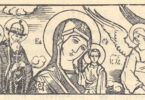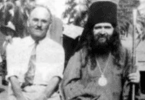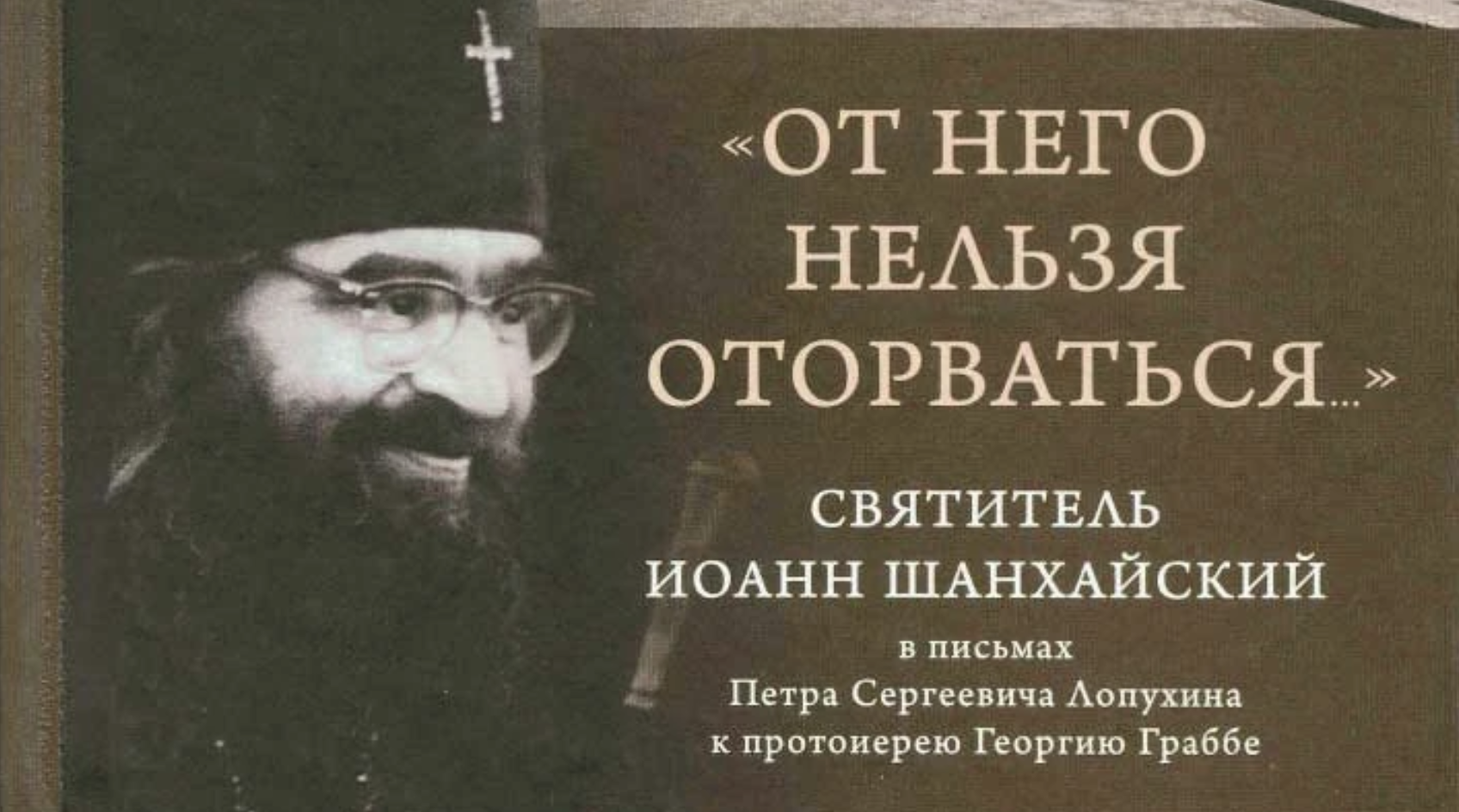He formed a sort of procession on the way into the church, preceded by young girls strewing flowers, which they collected before the service, in his path. Vladika Panteleimon had a great fondness for children, often passing out gifts of candy and coins from his pockets. The children came to congratulate him on the great feastdays, and he would read them poems and sing songs with them. Vladika Panteleimon also had great compassion for the poor; one day, upon noticing a barefoot beggar, he sat down and began to take off his boots. When his kellenik asked what he was doing, he said, “See? He has no shoes-it hurts my soul to see! Go get my shoes, I will give him my boots.” At one time, there was no one to sing in church. There was a poor family, talented singers, who had stopped coming to church. Vladika visited them, asking why they had stopped coming. He was told that they had no decent clothes to wear to church. Vladika gave them money for clothes, and asked them come and sing in church, which they did. While confined to the Zhirovitskii Monastery, Vladika Panteleimon authored several moral and religious essays, some of which were published in Lithuania. His simplicity, humility, and spiritual authority made him the natural leader of the resistance to unnecessary innovation in the Polish Church. In 1936, due to the persistent hostile activities of the Roman Catholic church against the Orthodox, Archbishop Panteleimon bravely wrote to the editor of the Polish newspaper Dziennik Wilenski, and noted that the refusal by Polish newspapers to refer to the Orthodox by their name, but simply as “schismatics,” was not only rude and uncivilized, as well as greatly offensive to the Orthodox, it was also a sin. In 1923 the Vatican sponsored a missionary movement for a “New Unia” in Poland. A newly consecrated Uniate Bishop, Henrik, was instructed to create “Polish Catholic parishes of the Orthodox Rite” in the largely Orthodox areas of eastern Poland. The Polish government was at odds with this missionary push by Rome, and was most definitely not interested in a “New Unia.” Even if the Roman Catholic Poles had not been persecuting the Orthodox, interest in a “New Unia” with Rome was non-existent among the Orthodox. In 1931, Pope Pius XI, addressing a group of pilgrims from Poland, stated: “Poland is my concern. The long border of your country is open to continual attacks by powerful Bolshevik ideas which are hostile to religion and Christianity. You adequately deflect these attacks, but, your mission is only complete when, as in the brilliant past, you will be able to say, “Every Pole is Catholic.” [1]op. cit. 50
A man who knew Vladika Panteleimon well recalled in his memoirs, “Orthodoxy in Poland quickly went downhill. Wandering from monastery to monastery, the venerable Archbishop, obviously with pain in his heart witnessing the tragedy of Orthodoxy, did not remain indifferent. Small pamphlets and leaflets of the Archbishop always kept up with the most difficult moments of the persecuted Orthodox, and did their good deed. His messages to the people from behind the walls of the Monastery were unusual … they never called for violence, nor did they remind the authorities of the immorality of their actions. They never tempted the people with gloomy prophecies. No. He explained to the people all the beauty, all the power, all the spiritual charm of Orthodoxy. Never making comparisons with other denominations, he showed the people the value of such a faith, what it really was. He quoted the vivid examples of our holy confessors of historic times in Russia, explaining why and what they did, and not otherwise, sometimes sacrificing lives solely for the Sweetest Jesus, who gives us through His Apostles the Orthodox Church, remaining indestructible passing through so many trials. The people were captivated by Vladika’s Orthodox soul, and captivated by their own Orthodoxy. In his immortal words, the light flared and blazed.” Vladika Panteleimon’s efforts simply did not allow the concepts of the nationalization of the Church, the new calendar, Uniatism and Catholicism to become part of the spiritual environment. The merits of the homilies of Vladika Panteleimon were undeniable, and his innate tact was at its utmost. [2]op. cit. 50
In March 1937, the Mitred Archpriest Vasily Bobkovskii was tonsured with the name “Venedikt.” In the same year, he was elevated to Archimandrite and named Abbot of the Zhirovitskii Monastery. In that monastery, there began a deep and inseparable friendship between Archimandrite Venedikt (Bobkovskii, later Archbishop of Berlin and Germany, ROCOR) and Archbishop Panteleimon. They would remain close friends and collaborators until the end of both their lives, reposing within a year of each other. Despite the troubled situation in the Church of Poland, the Zhirovitskii Monastery flourished as a haven for the faithful. [3]http://www.rocor.de/Vestnik/20015/html/06_bobkowskij.htm
On 1 Sep 1939, Germany invaded Poland. The Polish Army fell quickly to the “blitzkrieg.” Swiftly conquering Poland, the Germans stopped at a designated and prearranged “line.” This stopping point of the German Armies had been arranged with the Soviet Union. In a secret protocol to the Bolshevik-Nazi alliance known to history as the Molotov-Ribbentrop Non-Aggression Pact, it was determined that once Germany had successfully defeated Poland, the Soviet Union would occupy eastern Poland-the territories of Byelorussia and Ukraine that the Soviets had lost to Poland in the 1921 Treaty of Riga. Poland was, once again, removed from the map. Once the Red Army had occupied eastern Poland, the Moscow Patriarchate was quick to establish its jurisdiction. Metropolitan Dionisy lost approximately 80% of his flock to Moscow due to the Soviet occupation of eastern Poland. In the Pochaev Lavra, the question of commemoration came up. Metropolitan Sergius (Stragorodsky, later Patriarch, 1867-1944) was commemorated “temporarily” along with Metropolitan Dionisii. A “determination of the Moscow Patriarchate,” dated 20 Jun 1940, stated that the “autocephalous Order of the Metropolitan Dionisy for the Orthodox have no value,” including commemoration in the services. [4]Archbishop Afanassy (Martos) The Government, History & Church Life in Byelorussia @ http://www.pravoslavie.by/page_book/glava-ii-belorusskaja-pravoslavnaja-cerkov,[5] … Continue reading
The Soviets found church life in Western (Polish) Byelorussia well organized. There were 800 churches, five monasteries, and three dioceses. The Bishops of Vilna, Feodosy (Fedossiev), and Pinsk, Alexander (Inozemtsev, 1882-1948) stayed when the Red Army arrived. The Bishops Sava (Sovetov, 1898-1951), of Grodno, and Matfey (Semashko, 1894-1984), a vicar of the Vilna Diocese, fled the coming of the Soviets. Still interned in the Zhirovitskii Monastery, upon learning that Bishop Sava had fled, Archbishop Panteleimon took control of the Grodno Diocese. The Grodno clergy expected that Bishop Simon (Ivanov) of Ostrog would replace Bishop Sava, but he refused to come to Grodno. There were no protests concerning Archbishop Panteleimon taking charge of the Diocese. The presence of the Church in eastern Byelorussia, which had remained as part of the Soviet Union, was the opposite: there was nothing to organize. In Minsk, there were no churches open. In the summer of 1939, the last “official” church in Soviet Byelorussia, in Bobruisk, was closed. There were two Catacomb communities: one in Mogilev, one in Gomel. [6]ibid. 56
References
| ↵1 | op. cit. 50 |
|---|---|
| ↵2 | op. cit. 50 |
| ↵3 | http://www.rocor.de/Vestnik/20015/html/06_bobkowskij.htm |
| ↵4 | Archbishop Afanassy (Martos) The Government, History & Church Life in Byelorussia @ http://www.pravoslavie.by/page_book/glava-ii-belorusskaja-pravoslavnaja-cerkov, |
| ↵5 | http://ru.wikipedia.org/wiki/%D0%9F%D1%80%D0%B0%D0%B2%D0%BE%D1%81%D0%BB%D0%B0%D0%B2%D0%B8%D0%B5_%D0%B2_%D0%91%D0%B5%D0%BB%D0%BE%D1%80%D1%83%D1%81%D1%81%D0%B8%D0%B8_%D0%B2%D0%BE_%D0%B2%D1%80%D0%B5%D0%BC%D1%8F_%D0%92%D0%B5%D0%BB%D0%B8%D0%BA%D0%BE%D0%B9_%D0%9E%D1%82%D0%B5%D1%87%D0%B5%D1%81%D1%82%D0%B2%D0%B5%D0%BD%D0%BD%D0%BE%D0%B9_%D0%B2%D0%BE%D0%B9%D0%BD%D1%8B |
| ↵6 | ibid. 56 |










